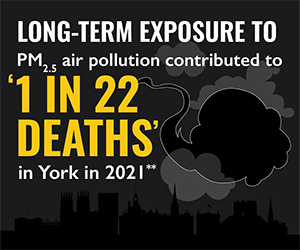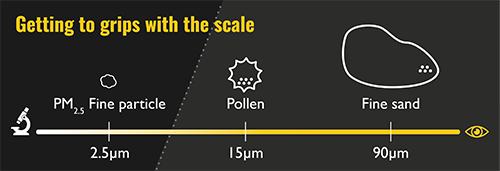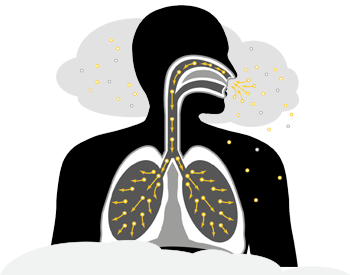Air pollution and health impacts of burning solid fuels
Burning wood makes the air we breathe worse, both inside and outside the home.
When we think about pollution we often think of chimneys, chugging out black smoke and smog, or cars belching out exhaust fumes. In fact, the most dangerous pollution to our health is often invisible, and burning solid fuel in our stoves and open fires at home is a major contributor to indoor and outdoor air pollution.
Burning wood and other solid fuels at home creates harmful particulate air pollution, also known as PM2.5 pollution.
According to government data, solid fuel burning in homes produces more PM2.5 pollution than all road traffic in the UK.
Particulate pollution is concerning because it can cause health impacts in vulnerable groups, such as:
- children
- the elderly
- those with illnesses or underlying health conditions, such as asthma and emphysema
While York meets the legal limit for particulate matter, there are no safe levels and everyone is at risk.
Long term exposure to PM2.5 air pollution contributed to 1 in 22 deaths in York in 2021.

It's estimated that long-term exposure to air pollution (specifically fine particulate, PM2.5) was a contributory factor to the cause of death in 4.4% of deaths in those over 30 years old in York in 2021. This is published as indicator D01 as part of the Public Health Outcomes Framework. There were 2045 deaths (all causes) of people in York aged 30 and above in 2021, so 4.4% is equal to around 90 deaths.
When you burn solid fuels, such as wood and coal, the microscopic PM2.5 particles in the smoke can travel deep into your lungs. From there, they get into your bloodstream and eventually they get to your organs including your heart and brain.
- in an hour, wood burning produces the same harmful PM2.5 air pollution as 6 lorries (Air Quality Expert Group (UK) (2017) Potential Air Quality Impacts from Biomass Combustion)
- harmful pollution is 3 times higher in homes with wood-burners (Emissions of air pollutants in the UK - Particulate matter (PM10 and PM2.5), February 2022 DEFRA) report
- PM2.5 is toxic and long term exposure to it increases a person’s risk of dying from cancer by more than 20%.
Getting to grips with the scale of pollution
PM2.5 is a very fine particle measuring just 2.5 micrometres (μm); 1 micrometre is equal to 0.001mm. It is smaller than fine sand (90μm) and pollen (15μm).
Fine sand and pollen can be seen with the naked eye, whereas smaller items such as PM2.5 are microscopic.
PM2.5 can easily penetrate deep into the lungs and cause health problems.

Particulate air pollution has a significant negative impact on the entire body, including the brain, heart, lungs, and liver:
- brain - headaches, anxiety, harmful effects on the central nervous system
- heart - problems caused throughout the cardiovascular system
- lungs - irritation, inflammation, infection, asthma, chronic pulmonary disease, lung cancers
- liver - serious impacts, including blood and spleen



